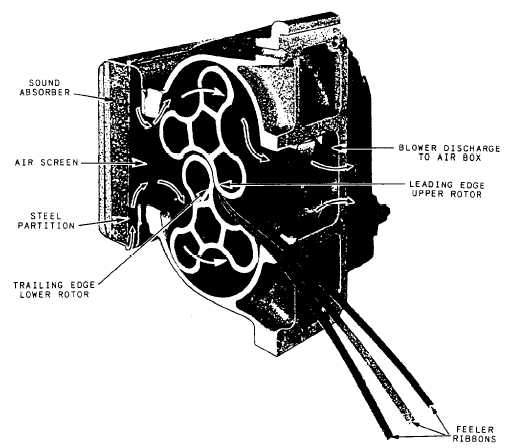axial-flow
positive-displacement
blower
(Hamilton-Whitfield), the problems of operation and
maintenance are similar.
Some of the troubles in a positive-displacement
blower are similar to those already mentioned in our
discussion of the centrifugal-type blowers. However,
the source of some troubles may be different because of
construction differences.
Positive-displacement blowers have a set of gears
to drive and synchronize the rotation of the rotors. Many
of these blowers are driven by a serrated shaft.
Regardless of construction differences, the basic
problem in both types of blowers is in maintaining the
necessary small clearances. If these clearances are not
maintained, the rotors and the case will be damaged and
the blower will fail to perform its function.
Worn gears are one source of trouble in
positive-displacement blowers. A certain amount of gear
wear is expected, but damage caused by excessively
worn gears indicates improper maintenance procedures.
Whenever you inspect a positive-displacement blower,
record the backlash values, according to PMS. You can
use this record to establish the rate of increase in wear,
to estimate the life of the gears, and to determine when
it will be necessary to replace the gears.
Scored rotor lobes and casing may cause blower
failure. Scoring of blower parts may be caused by worn
gears, improper timing, bearing failure, improper end
clearance, or by foreign matter. Any of these troubles
may be serious enough to cause the rotors to contact and
damage the blower extensively.
Timing of blower rotors involves both gear backlash
and the clearances between the leading and trailing
edges of the rotor lobes and between rotor lobes and the
casing. You can measure the clearance between these
parts with thickness gauges, as illustrated in figure 3-39.
If the clearances are incorrect, check the backlash of the
drive gear first. Then retime the rotors according to the
method outlined in the manufacturer’s technical
manual.
Failure of serrated blower shafts may be due to
failure to inspect the parts or of improper replacement
of parts. When you inspect serrated shafts, be sure that
they fit snugly and that wear is not excessive. When
Figure 3-39.—Checking clearances of positive-displacement blower lobes.
3-34

